| Martinectes Temporal range: Late Cretaceous (late Campanian), | |
|---|---|
 | |
| Skeleton cast, Rocky Mountain Dinosaur Resource Center | |
| Scientific classification | |
| Domain: | Eukaryota |
| Kingdom: | Animalia |
| Phylum: | Chordata |
| Class: | Reptilia |
| Superorder: | †Sauropterygia |
| Order: | †Plesiosauria |
| Family: | †Polycotylidae |
| Subfamily: | †Polycotylinae |
| Clade: | †Dolichorhynchia |
| Genus: | †Martinectes Clark, O’Keefe & Slack, 2023 |
| Type species | |
| †Martinectes bonneri Adams, 1997 | |
| Synonyms | |
| |
Martinectes is an extinct genus of polycotylid plesiosaur from the Late Cretaceous Sharon Springs Formation of the United States. The genus contains a single species M. bonneri, known from multiple skeletons and skulls. Martinectes was historically considered to represent a species of the genus Trinacromerum and later Dolichorhynchops before it was moved to its own genus.[1]
History
Two very large specimens of a polycotylid plesiosaur (KUVP 40001 and 40002[2]) were collected from the Pierre Shale of Wyoming and later reported on by Adams in her 1977 Masters thesis, and in the same year, she officially described the specimens as a new species of Trinacromerum (T. bonneri).[3] Unknown to her at the time, Carpenter (1996) had revised the Polycotylidae and separated Dolichorhynchops from Trinacromerum, raising the question as to whether or not the specimens represented a separate species or just larger individuals of D. osborni. A study in 2008 found that T. bonneri is a valid species of Dolichorhynchops, D. bonneri.[4] Carpenter (1996) estimated that KUVP 40001, with a skull measuring 98 centimetres (3.22 ft) long, had a total body length of more than approximately 5.1 metres (17 ft).[5] A 2023 study assigns D. bonneri to a new genus, Martinectes; the name means "Martin's swimmer".[1]
Classification
Clark, O’Keefe & Slack (2023) recovered Martinectes as a polycotylid member of the plesiosaur clade Leptocleidia, as the sister taxon to an unnamed polycotyline from the Niobrara Formation. This clade, in turn, is sister to Unktaheela. These species, together with Dolichorhynchops spp. (D. osborni and D. herschelensis), form the clade Dolichorhynchia within the Polycotylinae. The results of their phylogenetic analyses are shown in the cladogram below:[1]
References
- 1 2 3 Clark, Robert O.; O’Keefe, F. Robin; Slack, Sara E. (2023-12-24). "A new genus of small polycotylid plesiosaur from the Upper Cretaceous of the Western Interior Seaway and a clarification of the genus Dolichorhynchops". Cretaceous Research: 105812. doi:10.1016/j.cretres.2023.105812. ISSN 0195-6671.
- ↑ "Image: KU40001-4.jpg, (589 × 500 px)". oceansofkansas.com. Retrieved 2015-09-05.
- ↑ Adams, D. A. (1997). "Trinacromerum bonneri, new species, last and fastest pliosaur of the Western Interior Seaway". Texas Journal of Science. 49 (3): 179–198.
- ↑ O'Keefe, F. R. (2008). "Cranial anatomy and taxonomy of Dolichorhynchops bonneri new combination, a polycotylid (Sauropterygia: Plesiosauria) from the Pierre Shale of Wyoming and South Dakota". Journal of Vertebrate Paleontology. 28 (3): 664–676. doi:10.1671/0272-4634(2008)28[664:caatod]2.0.co;2. S2CID 32099438.
- ↑ Carpenter, K. (1996). "A Review of short-necked plesiosaurs from the Cretaceous of the western interior, North America" (PDF). Neues Jahrbuch für Geologie und Paläontologie, Abhandlungen. 201 (2): 259–287. doi:10.1127/njgpa/201/1996/259.
- ↑ Sato, Tamaki; Wu, Xiao-Chun; Tirabasso, Alex; Bloskie, Paul (2011-03-17). "Braincase of a polycotylid plesiosaur (Reptilia: Sauropterygia) from the Upper Cretaceous of Manitoba, Canada". Journal of Vertebrate Paleontology. 31 (2): 313–329. doi:10.1080/02724634.2011.550358. ISSN 0272-4634.

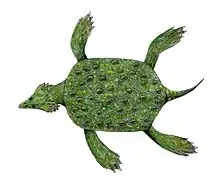
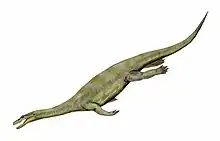
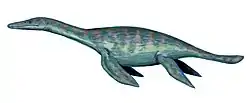

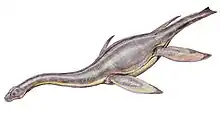
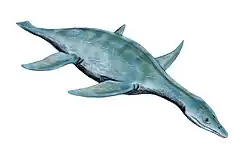
.png.webp)